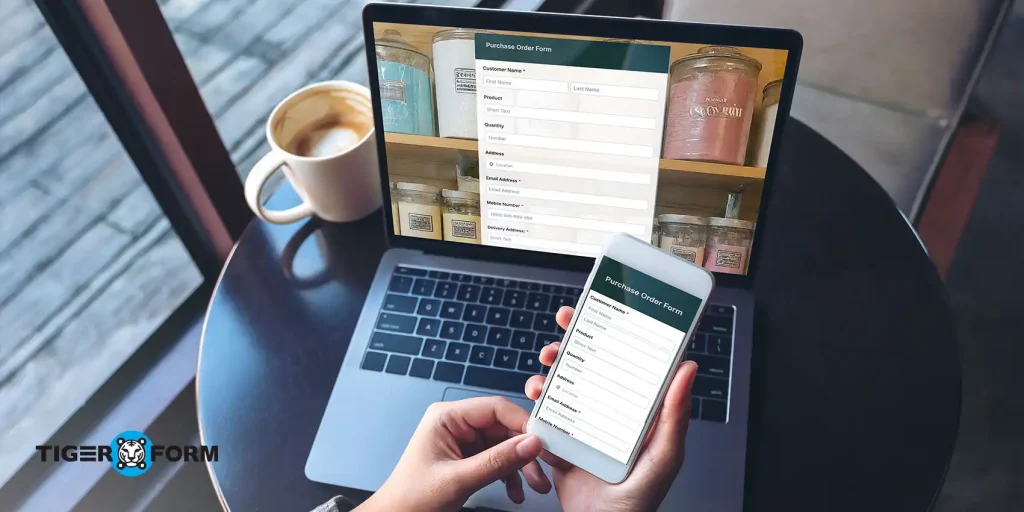
Order form templates fix a common yet often overlooked problem: inconsistent data. When every order looks different, it becomes harder and slower to process them. One customer might leave out their address, another spells their name five different ways. This slows down your operations and creates room for error.
That’s why using the right template matters. It helps you collect complete, usable information from the start, without the back-and-forth.
They also save your team from chasing missing details or correcting basic mistakes. Instead of spending time cleaning up messy submissions, you get precisely what you need, right from the first click.
A clean, clear order form makes your business look sharp. It tells people you’re organized, prepared, and ready to deliver. And a form template lets you skip the grunt work and launch with something that already works.
This post breaks down over 15 order form template examples worth using for different business types, why you should consider using one, and key tips to make your form effective.
What is an order form template?
An order form template is a pre-designed form in a form generator that helps to collect all the essential details needed to process an order. It typically includes fields like item name, quantity, customer information, payment method, delivery address, and special instructions.
The goal of using a template is simple: to standardize the ordering process. Instead of building a form from scratch every time or dealing with unstructured messages and emails, templates give you a reliable framework that ensures consistency, accuracy, and speed.
Order form templates are used across a wide range of industries:
- eCommerce businesses use them to capture product orders through their websites.
- Event organizers use them for ticket bookings or attendee registrations.
- Restaurants and food delivery services use them to take meal orders, pre-orders, or catering requests.
- Freelancers and creators use them for custom commissions, like art, writing, or photography.
- B2B companies to handle bulk or recurring product orders as part of their B2B marketing and sales workflows
Why use a template instead of starting from scratch?
1. Saves time on setup and revisions
Templates eliminate the need to build forms line by line. You don’t have to figure out which fields to include, how to arrange them, or whether the layout makes sense. I t’s already handled. Most templates can be customized in minutes, so you can launch quickly and make fast updates when needed.
2. Improves accuracy and reduces errors
One of the biggest issues with DIY forms is missed or unclear information. A solid form template includes all the essential fields, such as product name, quantity, delivery info, payment method, and special instructions, so customers submit complete and accurate orders. That means fewer mistakes and less clarification.
3. Creates a consistent experience for customers
Consistency builds trust. When every customer sees the same clean, intuitive layout, they know exactly what to expect and how to fill it out. That familiar structure reduces confusion and speeds up the ordering process, especially helpful for businesses handling recurring or high-volume orders.
4. Enables automation and system integration
Well-structured templates make automation easy. You can connect your form to:
- Spreadsheets (like Google Sheets) to instantly log orders
- Inventory or order management systems to track fulfillment
- Email or SMS tools to send auto-confirmations
- Payment gateways for fast, secure transactions
This turns your form into a smart, connected part of your backend, not just a place to collect data, but a trigger for your entire workflow.
5. Optimized for mobile, QR codes, and embeds
Most modern templates are mobile-responsive, so customers can place orders from any device without pinching or zooming. You can also:
- Generate a QR code to link directly to the form (great for flyers, packaging, or in-store signage)
- Embed the form directly into your website, landing page, or email
- Share it via social media, WhatsApp, or a direct link
This makes your form easily accessible, wherever your customers are.
6. Built-in design best practices
Templates are built with proven form design principles: clear labels, grouped fields, logical flow, and a balance between required and optional questions. That means fewer drop-offs, less confusion, and a much smoother experience from start to submit.
15+ order form template examples (with visuals + field list)
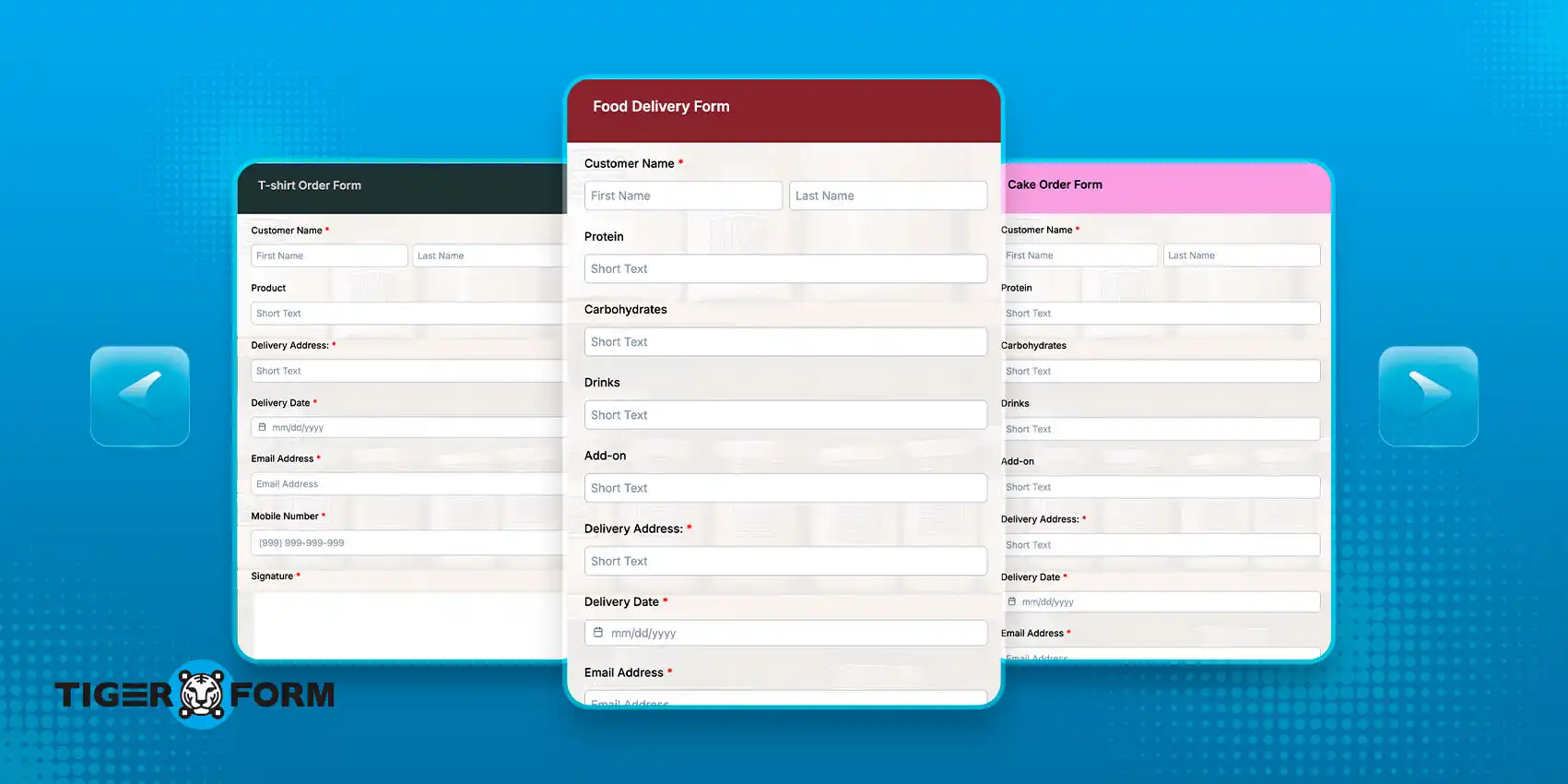
1. Product order form
This is your go-to form for selling tangible goods. It keeps the buying process simple while collecting just enough detail to fulfill the order without delays or errors. Add product images or dropdowns for variations to make it more interactive.
Perfect for: eCommerce sellers, direct-to-consumer (DTC) brands, small businesses, physical product sales
Key fields to include:
- Customer name
- Email and phone number
- Product name or SKU
- Quantity
- Size/variant selection (optional)
- Delivery address
- Payment method
- Special instructions (optional)
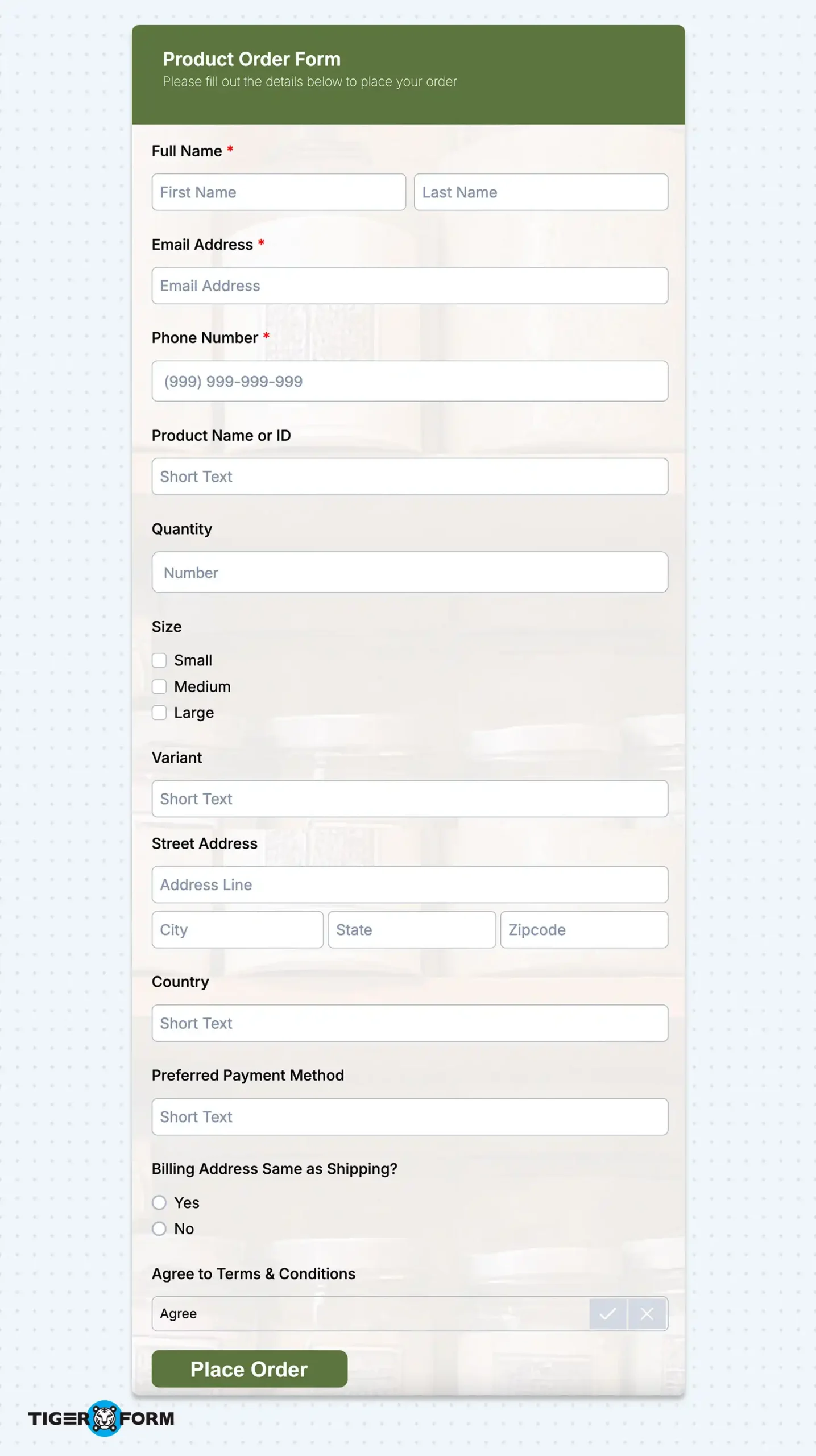
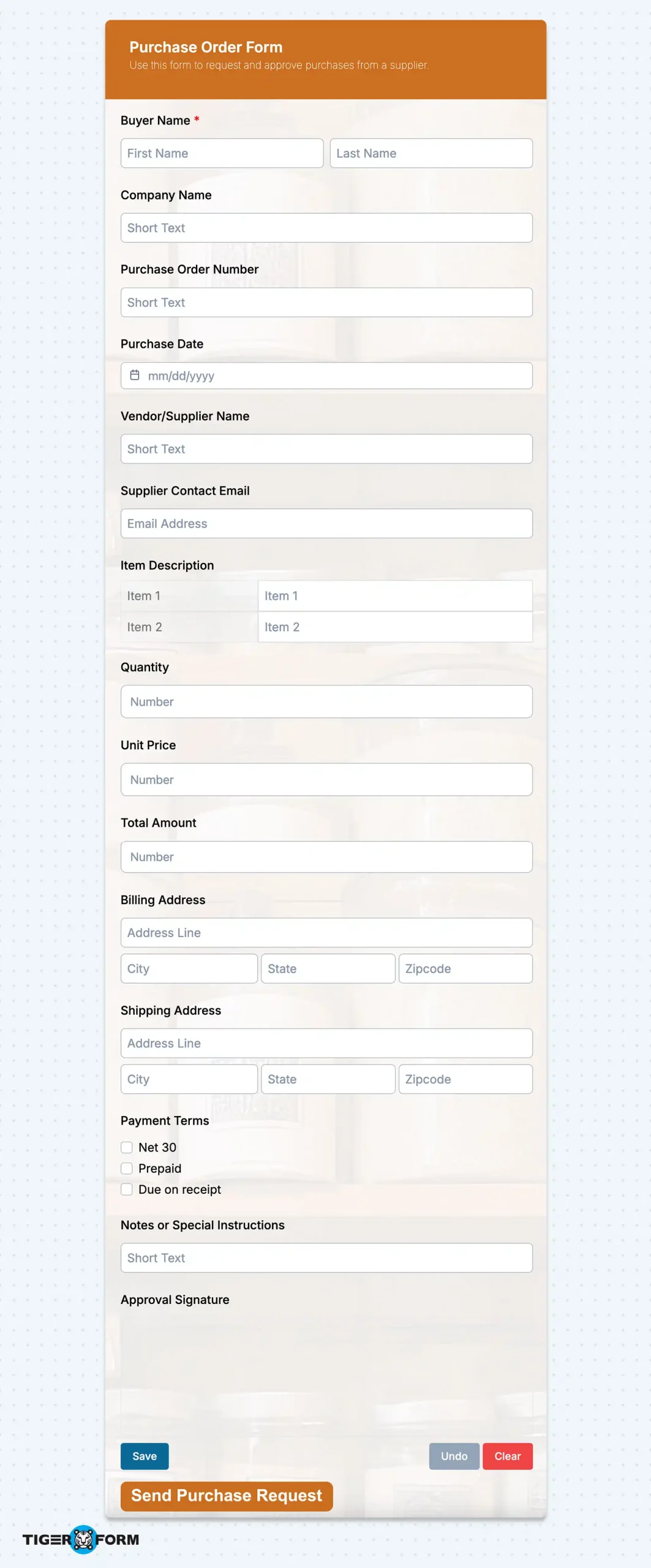
2. Purchase order form
A purchase order form is essential for formalizing business transactions. It documents what’s being ordered, in what quantity, from whom, and under what terms. It’s a key part of any procurement workflow if you order office supplies, equipment, raw materials, or resale inventory. This form helps reduce miscommunication, keeps financial records clean, and speeds up internal approvals.
Perfect for: Retailers, wholesalers, procurement teams, internal company requests, B2B transactions
Key fields to include:
- Approval signature (optional)
- Buyer’s name and company
- Vendor/supplier information
- Purchase order number
- Date of request
- List of items to be purchased
- Quantity per item
- Unit price and total amount
- Billing and shipping address
- Payment terms
3. Restaurant order form
A restaurant order form makes it easy for guests to place orders directly from their phone, and no server or paper is needed. It reduces order errors, speeds up service, and cuts down on staffing costs. This form becomes a self-serve experience that improves efficiency and customer satisfaction when paired with a QR code. If you’re running a cafe, food truck, or bistro, an online ordering platform with a mobile-ready restaurant order form helps you take orders fast without errors or staffing overhead.
Perfect for: Restaurants, cafes, bistros, food trucks, quick-service kitchens
Key fields to include:
- Customer name
- Contact details
- Menu item selection
- Quantity per item
- Delivery or pickup option
- Table number (if dine-in)
- Payment method
- Special instructions (optional)
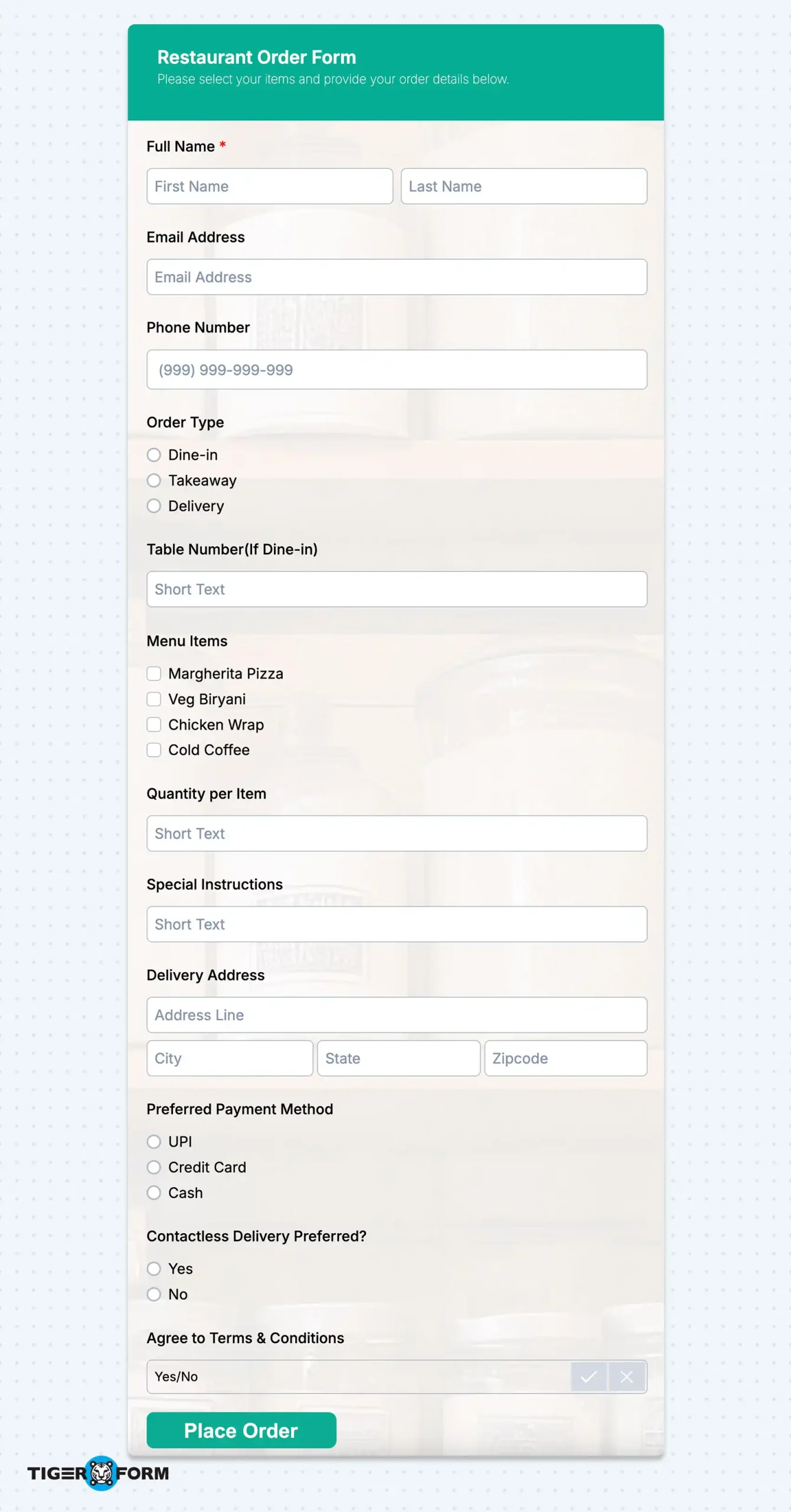
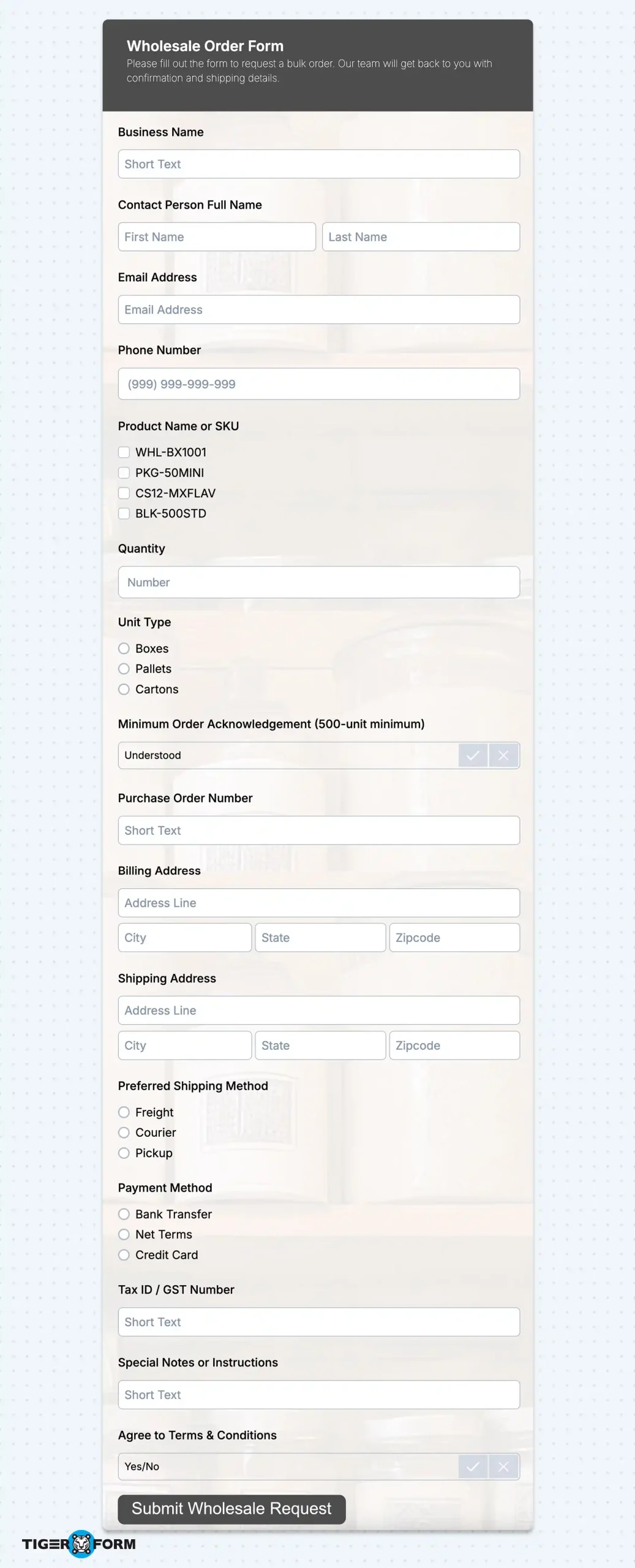
4. Wholesale form
This form is designed for businesses that handle large-volume or recurring product orders. It captures the structured data needed to process wholesale requests efficiently, without endless email threads or manual quoting. You can also set minimum quantity limits, integrate PO tracking, or link it to your inventory system.
Perfect for: B2B suppliers, manufacturers, distributors, bulk product sellers
Key fields to include:
- Business name and contact person
- Email and phone number
- Product selection (with bulk SKU options)
- Quantity per item
- Minimum order value (if applicable)
- Delivery or shipping details
- Payment method
- Purchase order number (optional)
- Special notes or tax info
5. Custom merchandise order form
Custom merchandise orders often involve a lot of backtracking: design specs, sizing, and personalization details. This form collects everything in one go: what the customer wants, how many, which sizes/colors, and where to ship. It makes the process faster and more accurate, especially for creators handling made-to-order items.
Perfect for: Print-on-demand businesses, creators selling custom T-shirts, mugs, hoodies, posters, or branded swag
Key fields to include:
- Customer name and contact info
- Product type (e.g., T-shirt, mug, hoodie)
- Design file upload
- Color and size selection
- Quantity
- Personalization notes (optional text or instructions)
- Delivery address
- Payment method
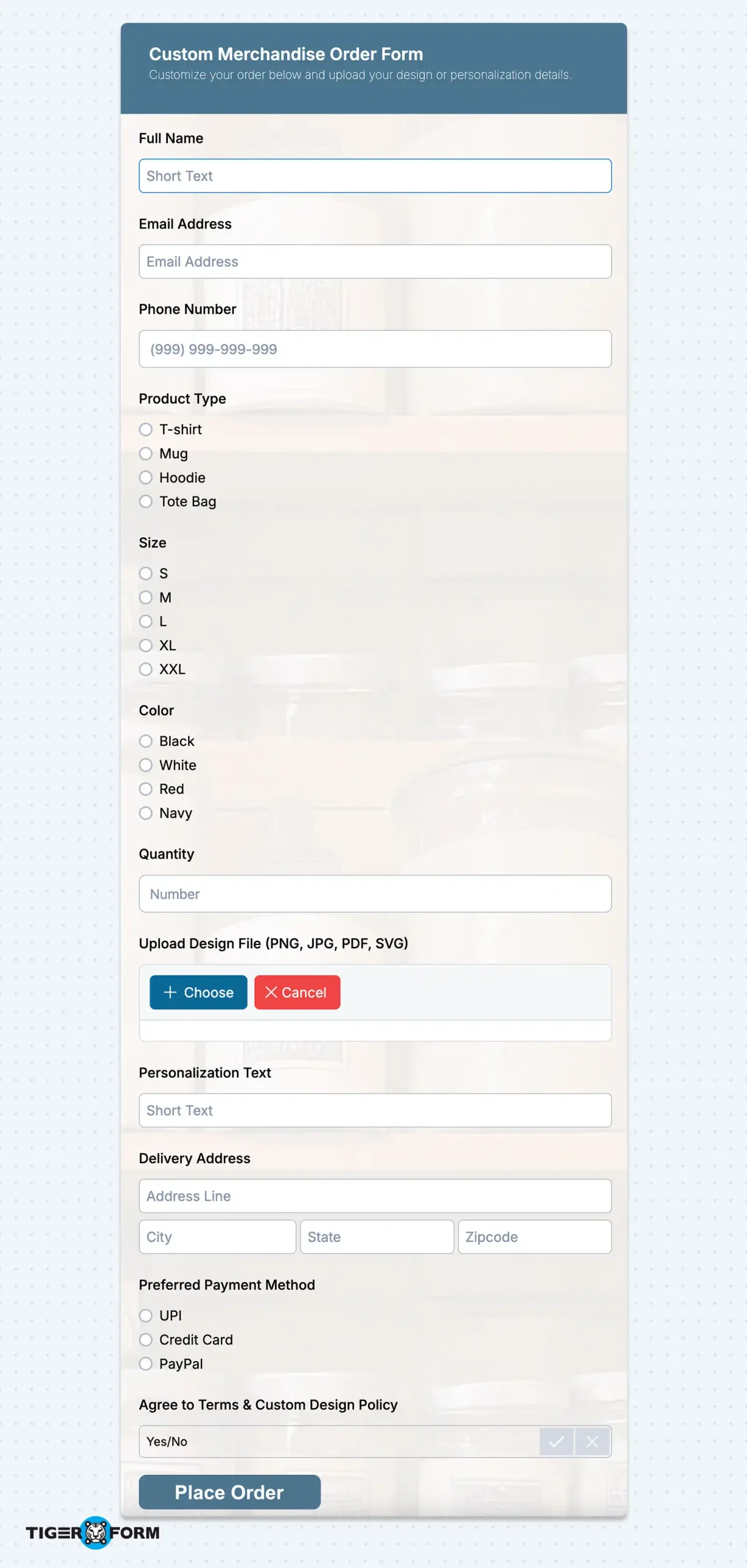
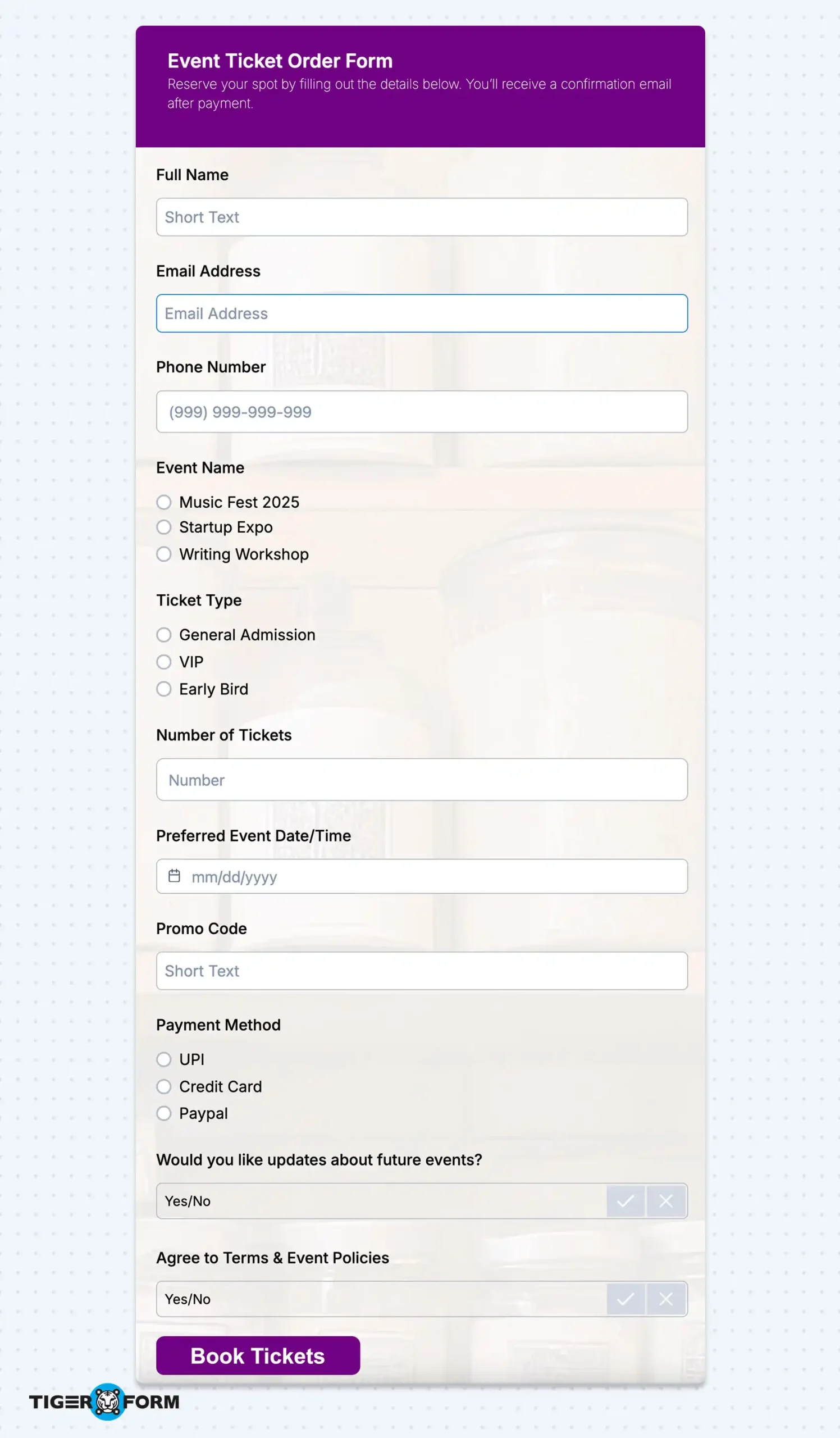
6. Event tickets
When you’re selling tickets to an event, speed and clarity matter. This form helps you collect attendee info, ticket preferences, and payments all in one go, reducing the risk of double bookings or missed details. You can even link it to a QR code system or auto-generate e-tickets on submission.
Perfect for: Event organizers, concert promoters, workshop hosts, conferences, fundraisers
Key fields to include:
- Auto-email confirmation
- Attendee name and contact info
- Event name (if multiple events)
- Ticket type or category
- Number of tickets
- Date and time (if multiple slots)
- Promo code (optional)
- Payment method
- Terms agreement
7. Cake/bakery order form
Custom cake orders often involve many little details flavors, sizes, themes, and dietary restrictions. This form helps you collect everything upfront, clearly, and consistently. There will be no missed calls or miscommunications just a smooth, professional order process your customers will love (almost as much as the cake).
Perfect for: Home bakers, bakery shops, custom dessert businesses, cake artists
Key fields to include:
- Payment method
- Customer name and contact info
- Type of item (e.g., cake, cupcakes, pastries)
- Flavor and filling
- Size or weight
- Quantity
- Design/theme instructions
- Pickup/delivery date
- Address (if delivery)
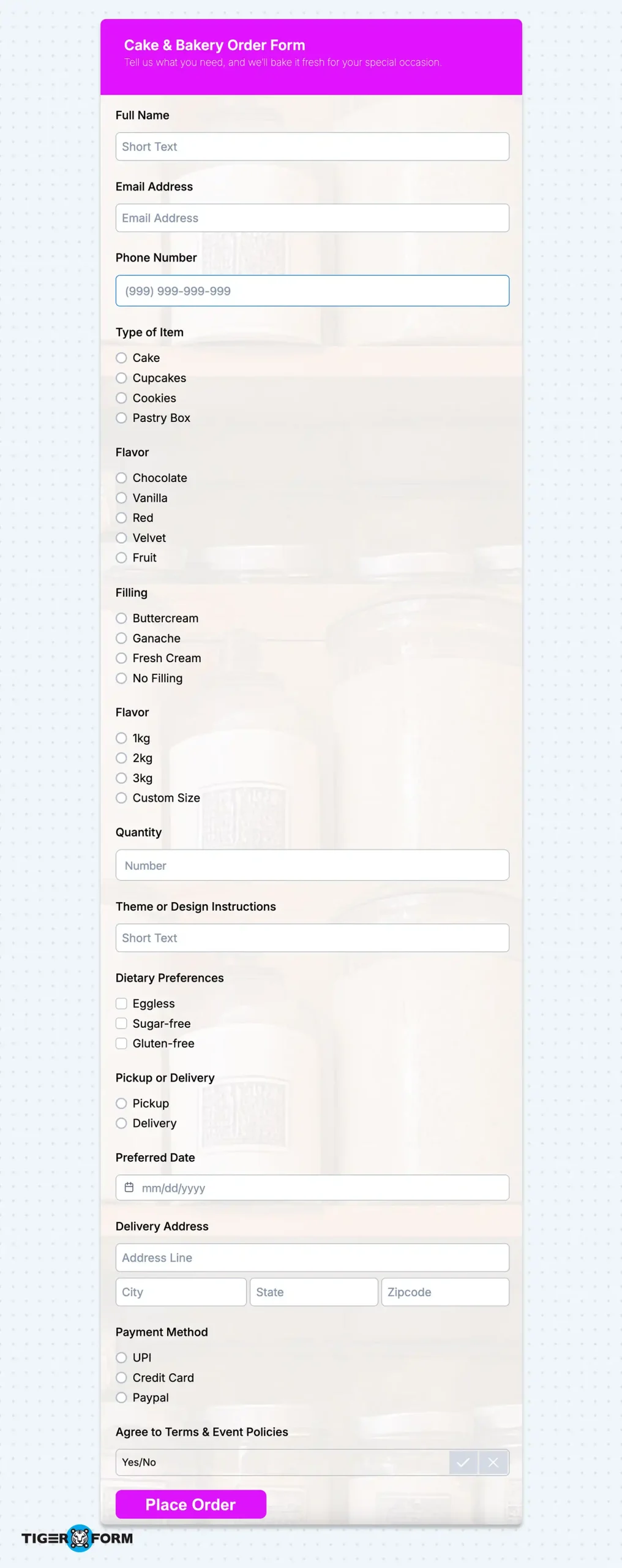
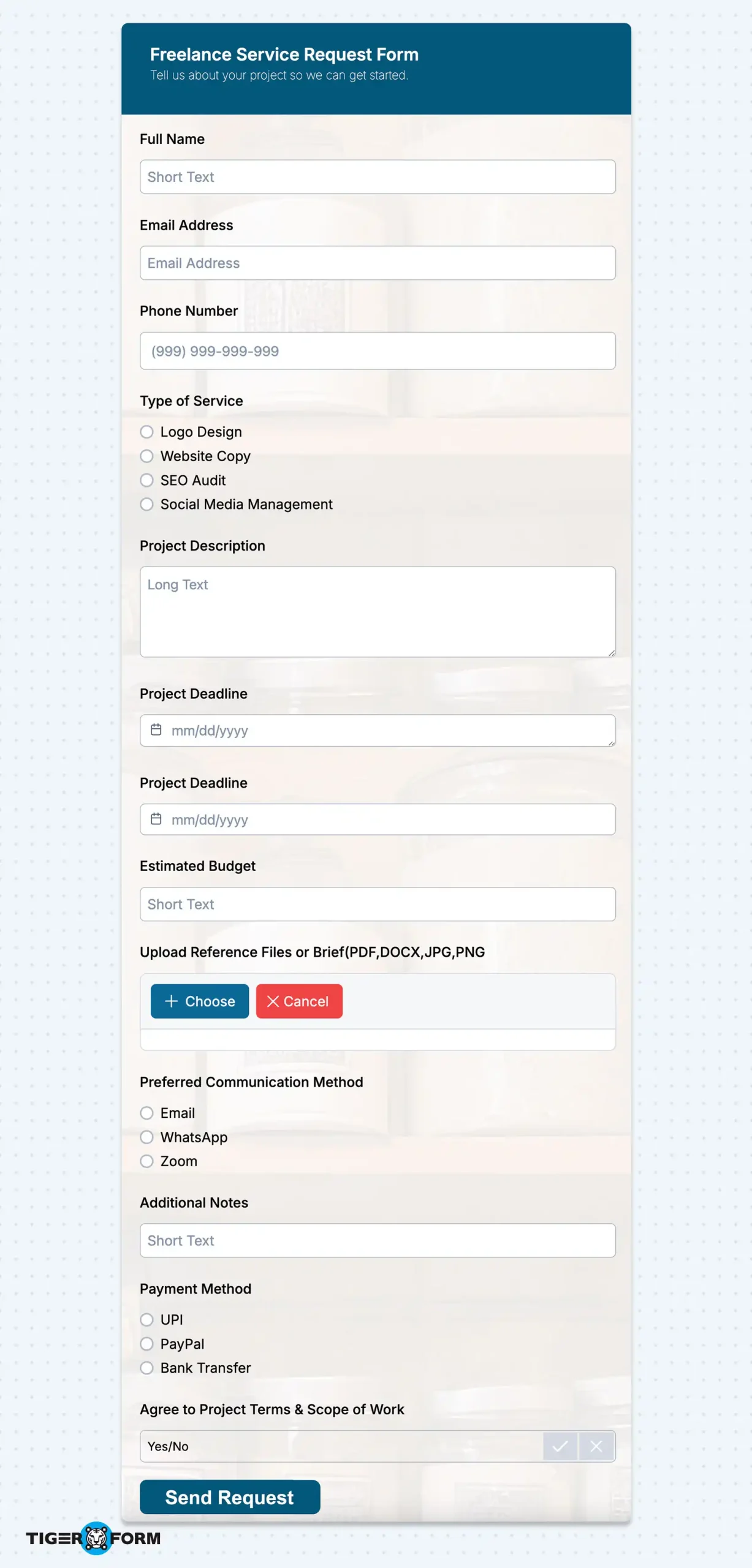
8. Freelance services
Freelancers often manage client expectations, scope creep, and unclear briefs. This form helps streamline the process by gathering the key project info upfront. It’s a simple but powerful way to set expectations, filter serious inquiries, and keep everything documented from day one.
Perfect for: Writers, designers, developers, marketers, editors, consultants anyone offering custom freelance services
Key fields to include:
- Terms and scope agreement
- Client name and contact details
- Type of service
- Project description
- Deadline or timeline
- Budget
- File upload (briefs, references)
- Payment method
9. Subscription boxes
Subscription box businesses rely on accurate, repeatable info. This form captures not only the basics like address and payment, but also preferences that personalize the box. It’s designed to reduce churn, prevent missed deliveries, and create a smoother onboarding experience for recurring customers.
Perfect for: DTC brands, wellness boxes, food kits, book clubs, grooming boxes, pet care subscriptions
Key fields to include:
- Customer contact info
- Box type or category
- Delivery frequency
- Start date
- Subscription duration
- Preferences (flavor, size, interests)
- Shipping address
- Payment method
- Auto-renewal confirmation
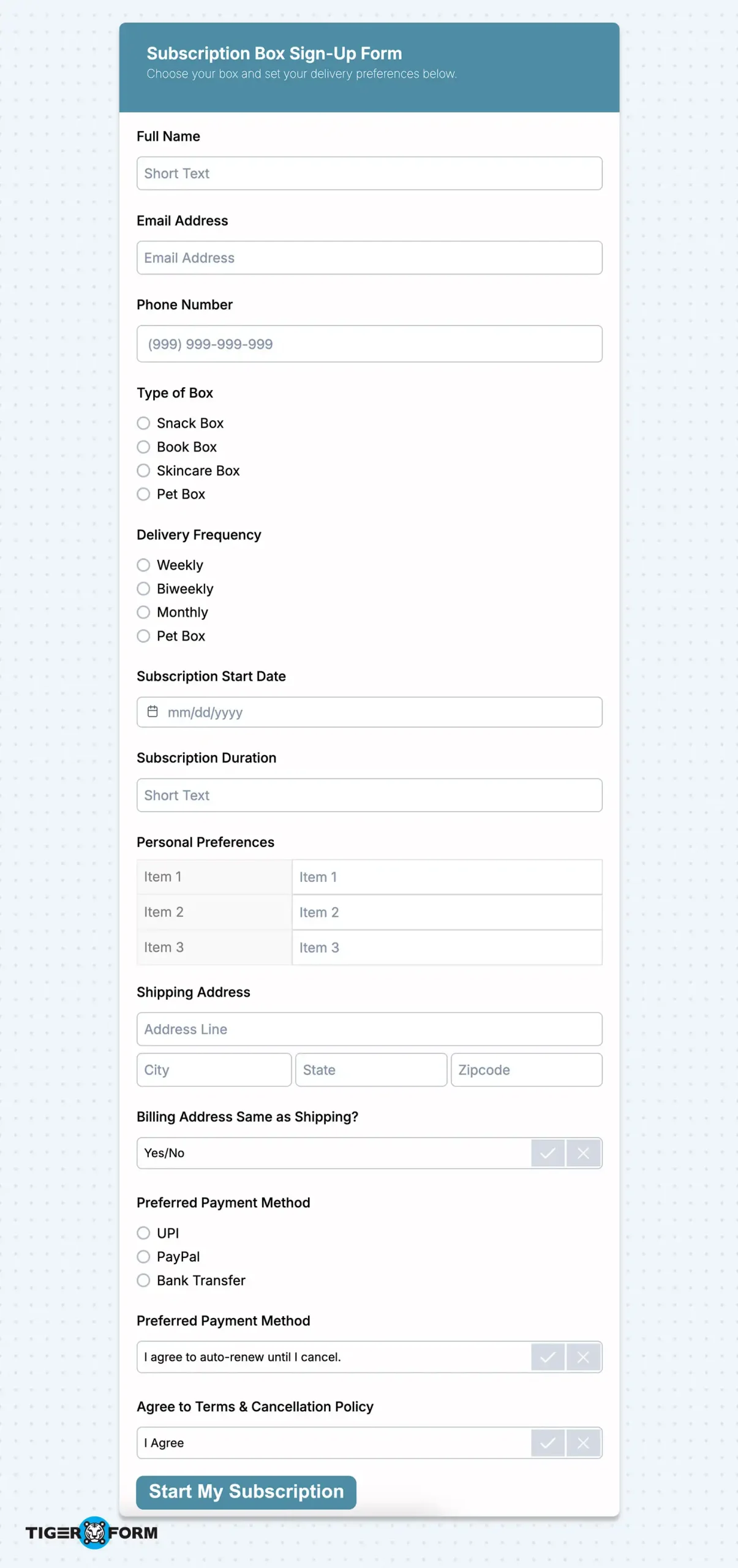
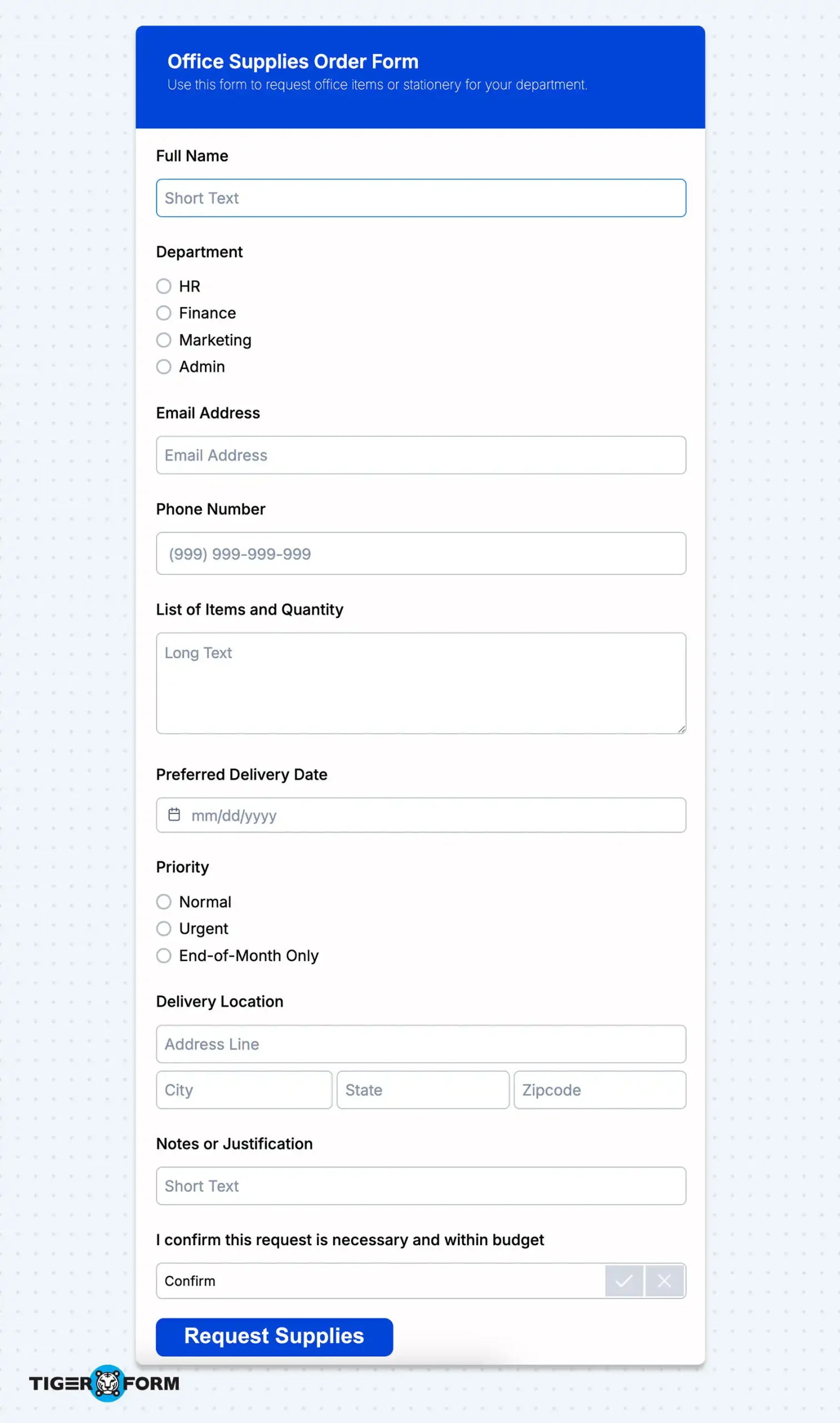
10. Office supplies
Ordering office supplies sounds simple until things get missed, duplicated, or delayed. This form keeps requests clear and centralized, helps avoid miscommunication, and allows teams to track inventory or spending. It is great for recurring internal orders or central supply requests.
Perfect for: Admin teams, office managers, HR departments, schools, and teams ordering stationery or equipment in bulk
Key fields to include:
- Requester’s name and department
- Contact details
- List of supplies needed
- Quantity per item
- Urgency or priority
- Delivery location (desk, floor, branch)
- Approval checkbox or manager info
- Notes for special requests
11. Pre-order form
Pre-orders help generate demand before a product goes live, but only if your process is clear. This form sets the right expectations by collecting all necessary information while confirming that customers understand the waiting period. It also helps you plan inventory, reduce overproduction, and avoid miscommunication.
Perfect for: Creators, brands, and businesses launching limited products, exclusive drops, or items not yet in stock
Key fields to include:
- Customer name and contact info
- Product name and variant
- Quantity
- Expected shipping date
- Agreement to wait
- Payment or deposit info
- Delivery details
- Optional notes or personalization
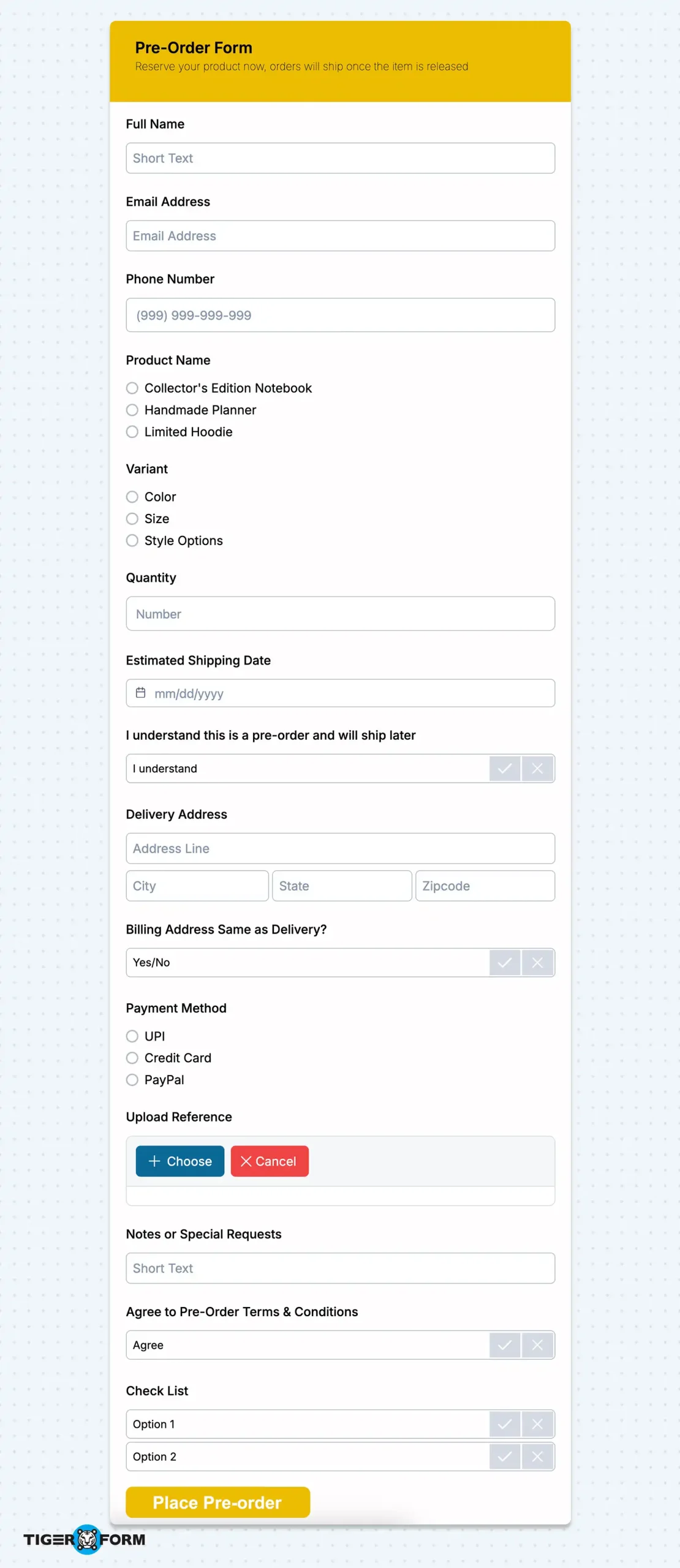
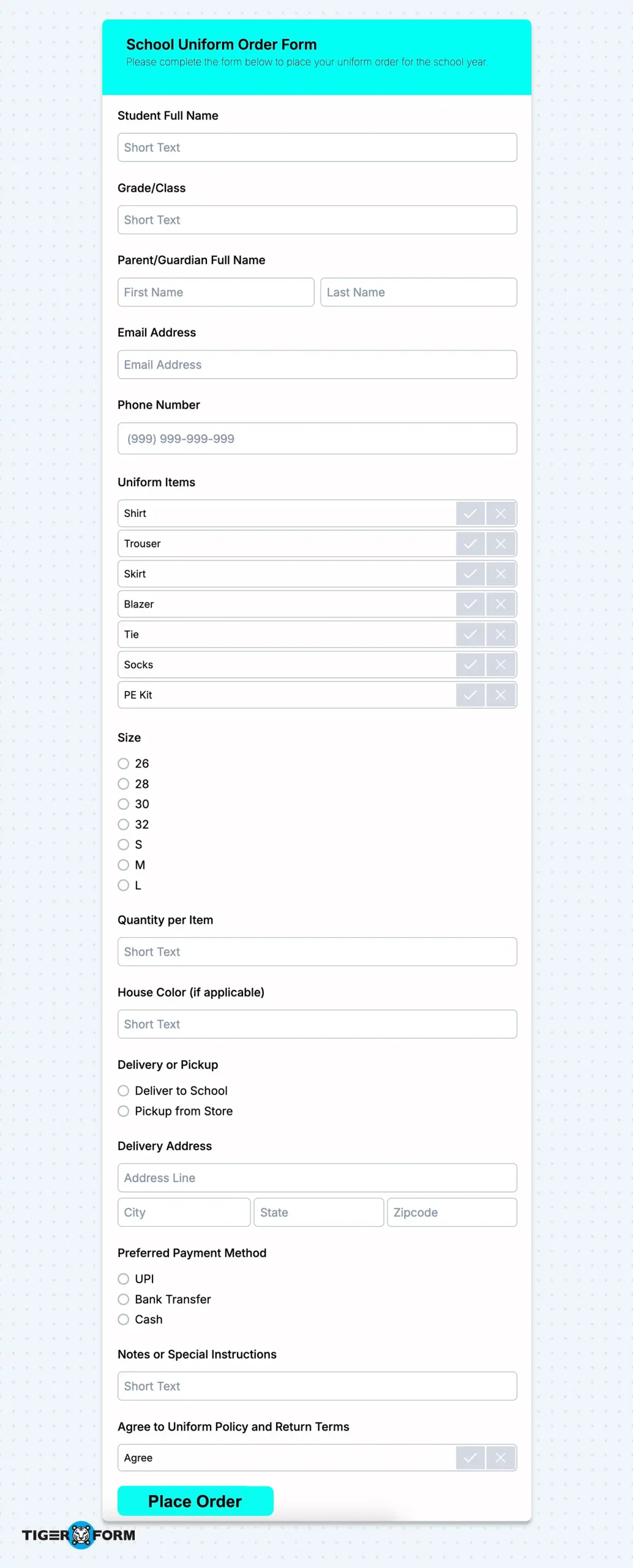
12. School uniform order form
Uniform orders are often chaotic, especially when you’re collecting sizes, variations, and contact info all at once. This form simplifies everything. Parents can submit one clear request, schools can track inventory in batches, and suppliers avoid mix-ups with sizes or house color variations.
Perfect for: Schools, uniform vendors, parent-teacher associations, and institutional suppliers taking student-specific orders
Key fields to include:
- Student name and grade
- Parent/guardian contact info
- Uniform item selection
- Size and quantity per item
- School or house colors
- Delivery or pickup preference
- Special instructions or notes
- Payment method
13. Art commissions
Commission requests can be vague or incomplete, leading to delays or misunderstandings. This form helps artists collect everything upfront, from style to deadline, so they can evaluate requests quickly, set fair expectations, and stay focused on the creative work.
Perfect for: Digital artists, illustrators, painters, designers, and creators offering custom artwork on request
Key fields to include:
- Client name and contact info
- Type of artwork
- Style or format preferences
- Description or concept
- File upload for references
- Size and resolution
- Usage intent (personal, commercial)
- Deadline
- Budget or pricing tier
- Payment method
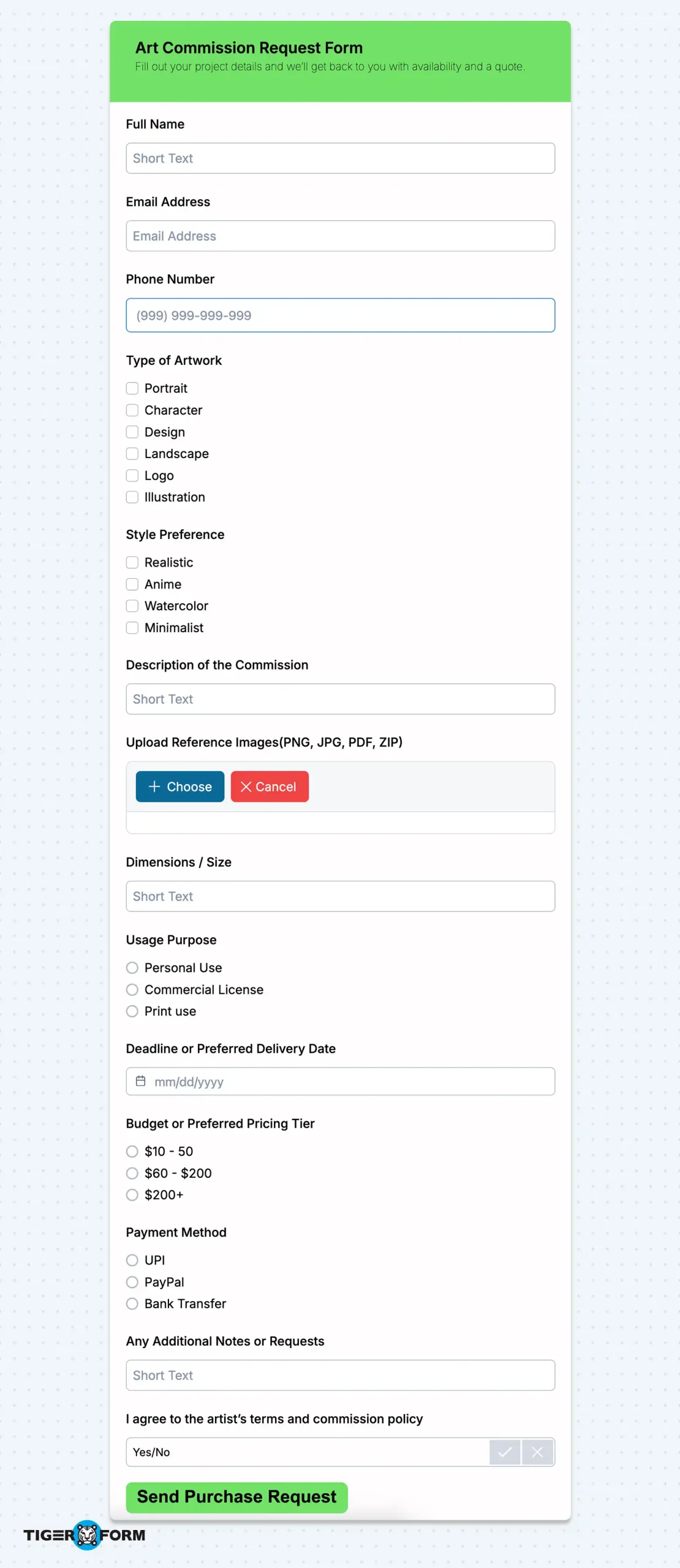
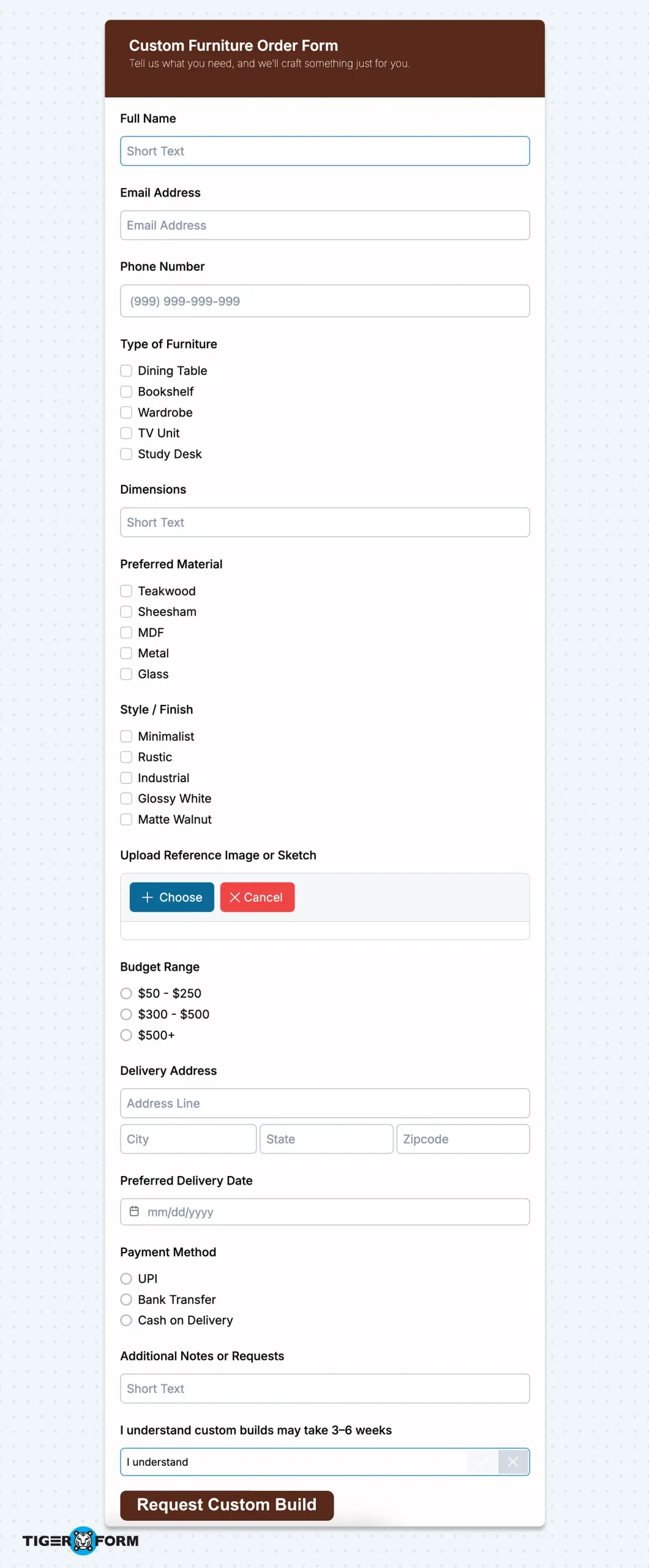
14. Furniture/custom build
Custom furniture requests are highly specific. People want things built to fit their space, taste, and budget. This form makes capturing all the important details up front easy, reducing confusion, revisions, and emails. It’s also a great way to qualify serious inquiries before starting any design work.
Perfect for: Furniture makers, interior designers, custom carpentry services, and home decor brands offering bespoke builds
Key fields to include:
- Client name and contact info
- Type of furniture
- Dimensions and material preferences
- Style or finish
- Upload a reference image or sketch
- Budget range
- Delivery location
- Timeline or deadline
- Payment method
15. Book/eBook purchases
Whether you’re selling a paperback, a PDF guide, or a Kindle-compatible file, this form captures everything you need for a smooth purchase flow. It reduces confusion over format (print vs. digital), handles delivery automatically or manually, and keeps your records clean.
Perfect for: Authors, indie publishers, bookstores, educators, or content creators selling physical books, eBooks, or learning guides directly
Key fields to include:
- Customer contact info
- Book/eBook selection
- Format preference
- Quantity
- Delivery email or address
- Payment method
- Notes for gift messages or download issues
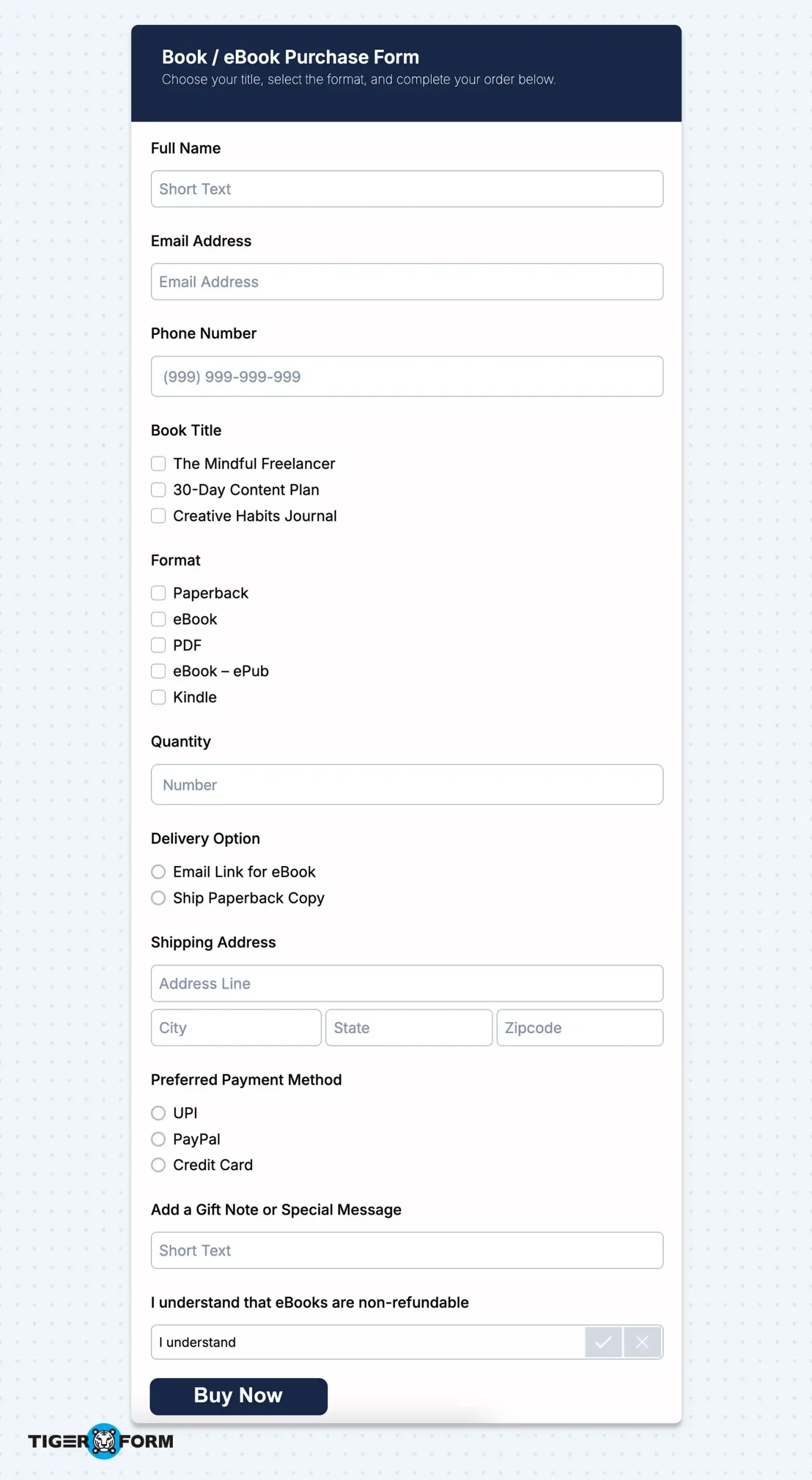

16. Gift card form
Gift cards are popular but easy to mess up without a structured form. This form collects exactly what’s needed to issue a digital or physical gift card: who it’s for, how much, and where to send it. Great for birthdays, holidays, or business gifting.
Perfect for: Retail brands, service providers, restaurants, salons, eCommerce stores, or creators selling digital/physical gift vouchers
Key fields to include:
- Buyer’s contact info
- Gift card amount
- Recipient name and email
- Delivery method (email or physical)
- Message or greeting
- Delivery date
- Payment method
17. Pharmacy/prescription order form
Prescription orders must be accurate and secure. This form helps patients submit medicine requests with all required details upfront, reducing wait time, errors, or unnecessary follow-ups. It’s ideal for both recurring prescriptions and one-time medication deliveries.
Perfect for: Pharmacies, clinics, telemedicine providers, or patients ordering prescribed medicines for home delivery or pickup
Key fields to include:
- Patient contact info
- Prescription upload
- Medicine name and dosage
- Quantity
- Doctor or clinic name
- Delivery method
- Payment option
- Special instructions or allergies

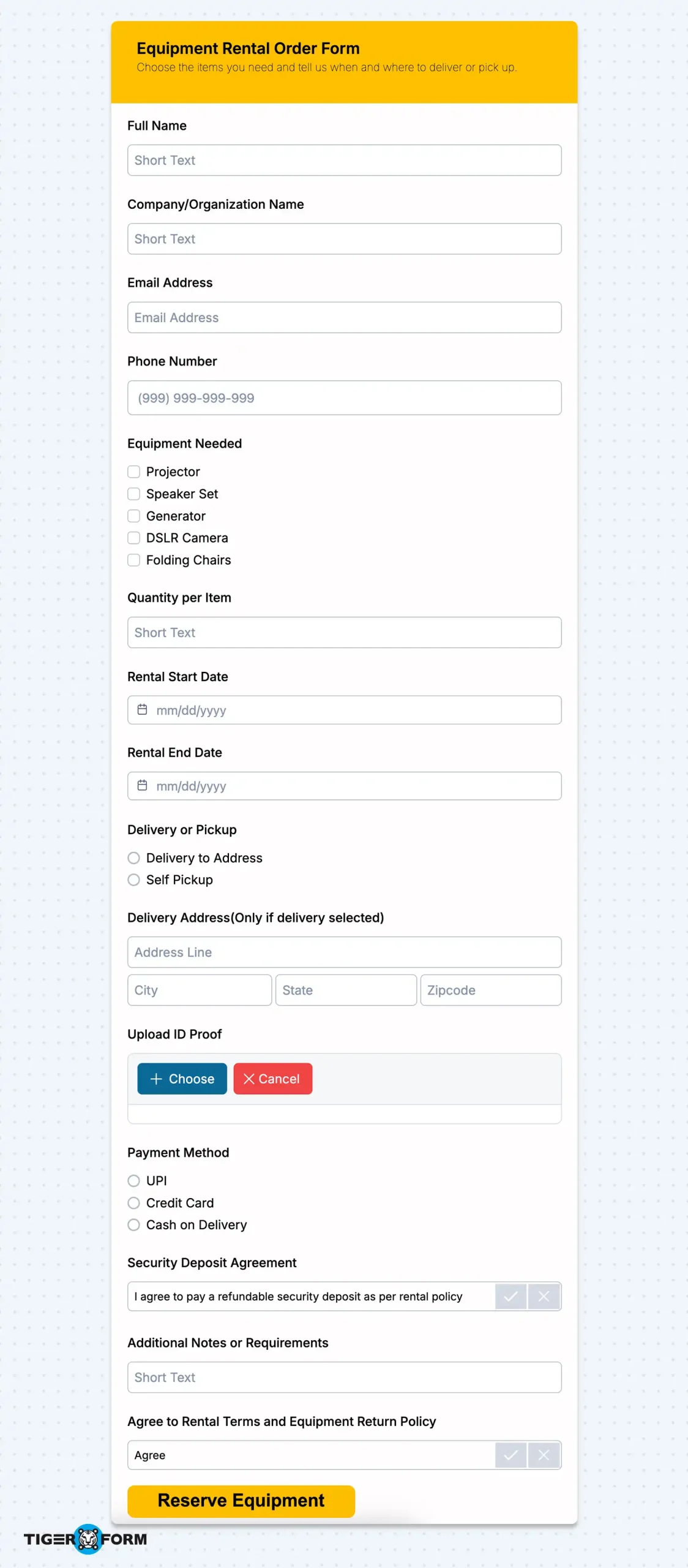
18. Rental equipment order form
Whether renting a speaker system for an event or a power tool for a construction job, rental businesses need clarity. This form collects everything up front from what’s being rented to when and where it’s needed. It helps prevent scheduling conflicts, ensures availability, and sets clear expectations around return timelines and fees.
Perfect for: Event planners, AV companies, hardware/tool rentals, camera gear providers, co-working spaces, and furniture rental businesses
Key fields to include:
- Renter contact info
- Equipment selection
- Rental duration
- Quantity
- Pickup or delivery option
- Security deposit details
- Payment method
- Terms acknowledgment
How to customize and use your order form
Using a template is just the first step; customizing it to match your business takes it from “generic” to “ready to go.” Here’s how to do that without getting overwhelmed:
1. Choose the platform that fits your needs
Start with a form builder to create and share your form. For example, TIGER FORM is a great option if you want a modern, mobile-friendly form with QR code integration.
2. Pick a template that matches your use case
Don’t waste time trying to adjust a form meant for something else. Choose a template built specifically for your type of order, like t-shirts, event tickets, or bakery items. That way, most of the structure is already in place.
3. Edit the fields to match your product or service
Open the form creator and tweak what you need. Rename product options, add pricing, remove irrelevant fields, and update your branding if the platform allows it. You’re not redesigning—just fine-tuning.
4. Add your details and settings
Include your actual product list, service descriptions, pricing, or any add-ons you offer. This is also the time to write a short confirmation message or set up alerts for new responses.
5. Enable payments if needed
If you’re collecting payments, turn on payment options like UPI, credit/debit cards, or PayPal (depending on the platform).
6. Share your form
Once it’s ready, you can share the link via email, WhatsApp, or social media. You can also embed it on your website or print a QR code for in-store use or flyers.
7. Track your orders automatically
If you want to stay organized, connect your form to a spreadsheet or a CRM tool. This helps you keep track of orders in real time without needing to sort through emails or PDFs later.
Best practices for effective order forms
A well-designed form makes life easier for both you and your customers. It helps people complete their order without confusion, frustration, or hesitation. Here’s how to make sure your form actually works:
1. Keep it simple
Don’t overcomplicate things. Stick to the essentials- name, contact info, product details, and payment. The fewer decisions someone has to make, the faster they’ll complete the form.
2. Avoid asking for too much at once
Every extra field is a potential drop-off point. If you don’t need someone’s company name or their exact address up front, leave it out or ask for it later. Only collect what’s necessary to process the order.
3. Use logic to improve the experience
Good form generators like TIGER FORM let you show or hide questions based on earlier answers. Use that to keep your form clean. For example, only show a “delivery address” field if someone selects “Home Delivery” instead of “Pickup.”
4. Always test it on mobile
Most customers will open your form on their phone. Check that it’s readable, that dropdowns and buttons are easy to tap, and that nothing cuts off or breaks on a small screen.
5. Add contact info and a clear confirmation
At the end of the form, let people know what happens next. Will they get an email? When should they expect delivery? Include a thank-you message and a way to reach you if something goes wrong that builds trust and reduces follow-up questions.
Build and launch your order form today
Order form templates are essential because people don’t always give you the necessary information unless you ask the right way. A good template guides the customer, captures every detail you need to fulfill the order, and leaves less room for errors.
If you’re selling products, offering services, or managing registrations, a well-structured form makes the process smoother on both sides. You get organized, accurate submissions, and your customers get a clear, simple way to place their orders.
So don’t start from scratch. Select a versatile form creator, pick a template that fits your use case, customize it in minutes, and launch with confidence. Want to get started? Visit TIGER FORM’s website and create your free account now.
FAQs
What should be included in an order form?
Include the customer’s name, contact info, product details, delivery address, and payment method. Only ask for what you need to fulfill the order accurately.
How do I create my order form?
Use a form builder like TIGER FORM, pick a template, and customize it with your products and fields. Then share it via link, embed, or QR code.
What are order templates?
Order form templates are ready-made with standard fields to help you collect orders quickly and consistently. They save time, reduce errors, and simplify the process.
